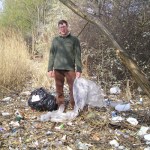conservation
tags: HR669, pets, exotic animals, invasive species, politics
Let's watch the legislative process in action, live: Subcommittee on Insular Affairs, Oceans and Wildlife Legislative Hearing on H.R. 669 (10:00 AM -- 1324 Longworth).
Take Action Now.
HR 669 Links:
Will HR 669 Transform Your Exotic Animals into Illegal Aliens?
My detailed analysis of HR 669 and its impacts.
Video discussing some of the impacts HR 669 will have on exotic animal breeders, pet store owners and scientists.
Are you a scientist, conservation biologist, biomedical researcher or exotic animal breeder who will be…
Like many other public universities around the country, Mystery U has been hit hard by the economic hard times. Most of this year, we heard ominous rumblings that (at some point) there would be a budget reversion, i.e., we'd have to send some portion of our budget back to the state coffers. But all was pretty much business as usual until a few weeks ago when the axe fell. Instantaneously our whole university budget and we were under strict orders to conserve the precious resources we still had...you know, things like copier paper. Because we have no money to buy any more.
I've been biting my…
tags: Birds in the News, BirdNews, ornithology, birds, avian, newsletter
Male Scarlet Tanager, Piranga olivacea, photographed in Newton Hills State Park in South Dakota.
Image: Terry Sohl, 7 June 2008 [larger view].
Photo taken with a Canon 20D, 400 5.6L.
Birds in Science and Technology
Climate change will force bone-weary birds migrating to Europe from Africa to log extra mileage, with possibly devastating consequences, according to a study released recently. The annual voyage of some species, which fly north in search of food and suitable climes, could increase by as much as 400km, the…
tags: 'Alala, Hawaiian Crow, Hawaiian Raven, Corvus hawaiiensis, endangered species, conservation
One of the last wild-born `Alalâ to ever be photographed in the wild.
Image: The Honolulu Advertiser.
One of the rarest forest birds in the world, the critically endangered `Alalâ, or Hawaiian Crow, Corvus hawaiiensis, was awarded $14.3 million in conservation funding over the next five years, according to the United States Fish and Wildlife Service (USFWS).
This funding package will focus on expanding captive propagation, establishing new populations in managed habitat, protecting…
tags: HR669, pets, exotic animals, invasive species, pet animal trade, PetSmart, politics
As expected, PetSmart has officially spoken out against HR 669. As a large corporation, you KNOW PetSmart has a flock of lawyers who are studying legislation such as this to make sure that laws are not enacted that would damage them or their clients. While PetSmart supports the primary aim of this bill -- to prevent the introduction of potentially invasive nonnative animal species into this country -- they point out that HR 669, as written, will damage the pet industry and harm pet owners ("pet parents…
I am writing an OpEd argument against HR 669, The Nonnative Wildlife Invasion Prevention Act, and I have pitched an analysis of HR 669 to a magazine where it will be published very rapidly. One thing that I want to include in my writing is mention of any conservation efforts or scientific research that will be negatively impacted by HR 669, and I thought you might be able to help me. If your conservation program or scientific research (or that of your colleagues) could be negatively impacted by HR 669, can you email a statement that includes these details; (1) your research species (2) a…
tags: Birds in the News, BirdNews, ornithology, birds, avian, newsletter
The only egg known to be collected by Charles Darwin, recently rediscovered.
Image: University of Cambridge.
Birds and American Law
The American Federation of Aviculture Inc. (AFA), the Avicultural Society of America (ASA) and the National Animal Interest Alliance (NAIA) issued an action alert together that opposes H.R. 669, a bill banning most nonnative animals in the United States. "H.R. 669 is an 'anti-animal bill'. There is no amendment that can fix this bill," states the action alert. H.R. 669 is a bill that…
tags: Birds in the News, BirdNews, ornithology, birds, avian, newsletter
In a dramatic discovery, BirdLife has filmed Common Cuckoos calling with a "Ooo-Cuck, Ooo-Cuck". (April fools?)
Image: Greg & Yvonne Dean/WorldWildlifeImages.com.
Birds in Science and Technology
Count your chickens after they hatch, and they may do a little arithmetic themselves. Chicks only 3 or 4 days old manage an animal version of adding and subtracting, says Rosa Rugani of the University of Trento Center for Mind/Brain Sciences in Rovereto, Italy. Inspired by experiments with human babies, Rugani and her…
tags: Bumblebees, Bombus species, Hymenoptera, insects, entomology, natural history
Common Eastern Bumblebee, Bombus impatiens.
This species is often relied upon to pollinate commercial food crops,
such as tomatoes, that are often grown in agricultural greenhouses.
Image: Wikipedia [larger view].
The Bumblebees, Bombus species, are among the most popular of all insects. Their black-and-yellow fuzz, large round bodies, and bumbling, buzzing flight make them appear almost cuddly, almost like the "teddy bears" of insects. I have many childhood memories of watching these appealing gentle…
tags: Birds in the News, BirdNews, ornithology, birds, avian, newsletter
American Avocet chick, Recurvirostra americana.
Image: Richard Ditch, 2007 [larger view].
Birds in Science and Technology
Researchers have discovered the first direct evidence that exposure to stress in young birds affects the way they react to stress when adult. Exposure to stressful events soon after birth has significant effects on a range of physiological and behavioral responses later in life. Previous work in mammals has been unable to work out whether this is due to raised stress hormone levels produced by…
Last weekend I did the beach clean-up thing again, and again I went along with my son, my mum (Sandra), and about 40 other people. There's always something new to say about the problem of litter and plastic pollution: once again, I thought I'd pen some random musings on the experience, and on the problem of litter and pollution in general.
There's every reason to be depressed about the fact that, thanks to our species, many environments and ecosystems are royally screwed, but there's hope in the fact that more and more people are at least aware of the situation, and more and more are acting…
tags: migratory birds, BirdLife, conservation, streaming video
Wow, this inspiring and moving video shows us some of the world's many migratory bird species and pleads with us to make their journey safe again. The music and footage is glorious, so sit back and turn your speakers up [5:23]
Hopefully it is well known that we still have a lot to learn about the planet's extant macrofauna. And, by 'macrofauna', I'm not talking about nematodes, molluscs or insects but, yes, about such things as mammals. In fact, on mammals specifically, discovery rates indicate that we really should expect the discovery of new species for a long while yet. In a new article in Proceedings of the National Academy of Sciences, Ceballos & Ehrlich (2009) bring attention to the fact that 408 new mammal species (representing about 10% of the total mammal species inventory and belonging to 18…
tags: The State of the Birds 2009, ornithology, birds, endangered species, conservation, global warming, climate change, environment, invasive species, habitat loss
Streaming video [6:31]
According to the most comprehensive report ever published in the USA, nearly one third of America's 800 native bird species are endangered, threatened, or in significant decline, thanks to habitat loss, pollution, climate change, competition from invasive species and other threats.
The shocking report, published by the US Fish and Wildlife Service, reveals that of the more than 800 bird species that…
tags: Birds in the News, BirdNews, ornithology, birds, avian, newsletter
Wren (known as the "Winter Wren" in the United States), Troglodytes troglodytes, photographed near the Bridge of Orchy, Scotland.
Image: Dave Rintoul, Summer 2008. [larger view].
Birds in Science and Technology
What happens when the demand for suitable nesting sites exceeds the availability? The law of demand and supply also applies in nature, and the consequences of enhanced competition for limited nesting sites can have far-reaching effects. Which individuals will prevail? And what happens to the unsuccessful…
tags: windmills, windpower, bird-friendly windpower, conservation, environment, streaming video
Here's an intriguing video describing affordable and bird-friendly windmills that are competitive with more traditional windmills, and are designed to be used in urban and suburban areas as well as out in the countryside [2:02]
Last year we participated in Earth Hour, an international movement demonstrating that millions of people around the world are ready to do something about climate change. Join us again on Saturday March 28, 2009 at 8:30PM (your local time):
This year, Earth Hour has been transformed into the world's first global election, between Earth and global warming.
For the first time in history, people of all ages, nationalities, race and background have the opportunity to use their light switch as their vote - Switching off your lights is a vote for Earth, or leaving them on is a vote for global…
Tigers can no more change their stripes than leopards can change their spots. That's a good thing too, for their unchanging patterns, as individually distinct as a human fingerprint, make it easier to track any single tiger over time.
That process is about to become even simpler with a computer programme that creates a three-dimensional model of a tiger's skin and can compare different shots of an animal taken at different times or angles. The programme is the brainchild of Lex Hilby from an organisation called Conservation Research and it could allow conservationists to track surviving…
The Guardian:
Human pollution is turning the seas into acid so quickly that the coming decades will recreate conditions not seen on Earth since the time of the dinosaurs, scientists will warn today.
Say what?! Look, ocean acidification is a VERY real threat to our planet. That said, the seas are not turning to acid! (But gee, way to scare folks into envisioning the demise of the wicked witch!) This demonstrates a lack of taking the time to explore and understand what ocean acidification means--the term is used to describe the way the pH of oceans is becoming less basic as they absorb…
In 1992, a small group of 12 and 13 year olds from the Environmental Children's Organization (ECO) raised money to attend the Earth Summit in Rio de Janeiro. This is Severn Suzuki's address to delegates.
Nearly early two decades later, her words are as relevant as ever. Are we doing any better?

